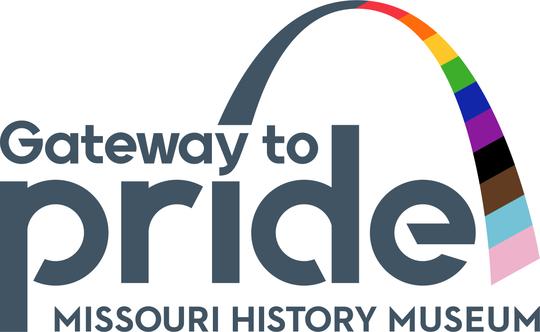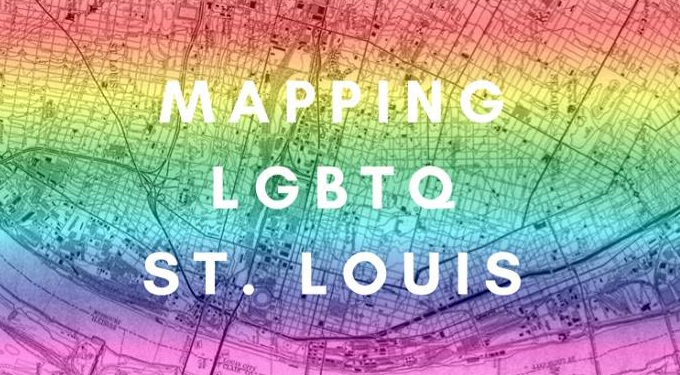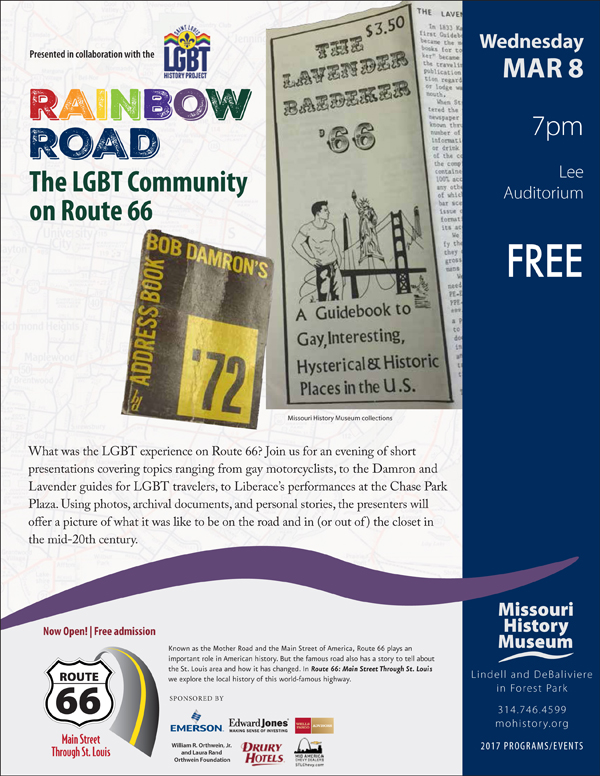June 2017: Project's National Archives Exhibit
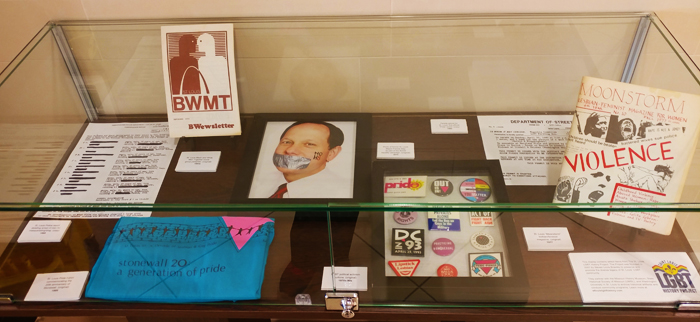
June 8, 2017: The Project has created a special June Pride Month display by special invitation from the National Personnel Records Center (NPRC), part of the National Archives (NARA) in St. Louis.
Thanks to Archives Technician Katherine A. Terry for inviting the Project to create the display and for garnering the necessary approvals for the display. This is the first time NPRC has asked an outside group to create a LGBTQIA display at their facilities.
Items in the display include: 1989 Pride St. Louis shirt, various Pride buttons, 1977 issue of Moonstorm, Mayor Slay's NOH8 campaign photograph, Black and White Men Together brochure, the 1980 Pride Parade permit, and a 1969 police report regarding men being arrested for masquerading.
The NPRC and NARA at St. Louis are part of a nationwide network of NARA’s 44 facilities of regional archives, Federal records centers, Presidential libraries, and its Washington, D.C., and College Park, Md., offices.
The exhibit is on display in the NPRC's main lobby through June at 1 Archives Drive, Spanish Lake, MO 63138. Guests must go through a security checkpoint.
Image courtesy of Katherine A. Terry.
June 8, 2017 Missouri History Museum Presentation
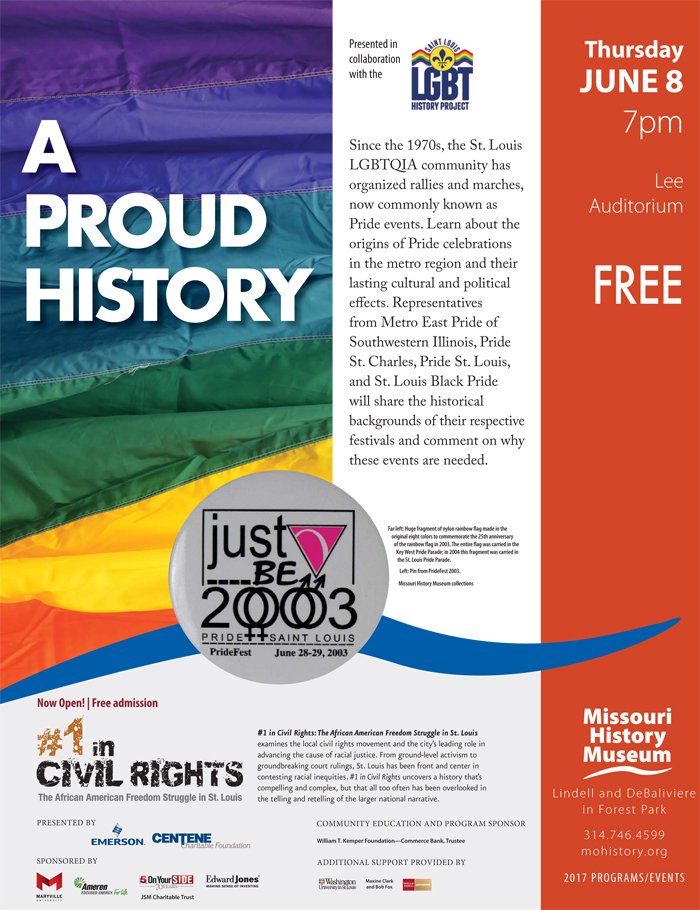
May 11, 2017: Since the 1970s, the St. Louis LGBTQIA community has organized rallies and marches, now commonly known as Pride events. Learn about the origins of Pride celebrations in the metro region and their lasting cultural and political impact. Project collaborator Jayms Andris will offer an overview of the 1970s events that led to St. Louis’ first official Pride week in 1980. Representatives from Metro East Pride of Southwestern Illinois, Pride St. Charles, Pride St. Louis, St. Louis Black Pride, and Tower Grove Pride have been invited to provide historical backgrounds about their respective festivals and comment on why the events are needed.
Thursday, June 8, 2017, 7 pm
Missouri History Museum, Lee Auditorium, Forest Park
Free
March 8, 2017 Presentation at Missouri History Museum
February 13, 2017: Don't miss the Project's upcoming presentation at the Missouri History Museum.
Rainbow Road: The LGBT Community on Route 66
Wednesday, March 8, 2017, 7 pm
Missouri History Museum, Lee Auditorium, Forest Park
Free
Christmas Memories - Giving Back
By James Hawkins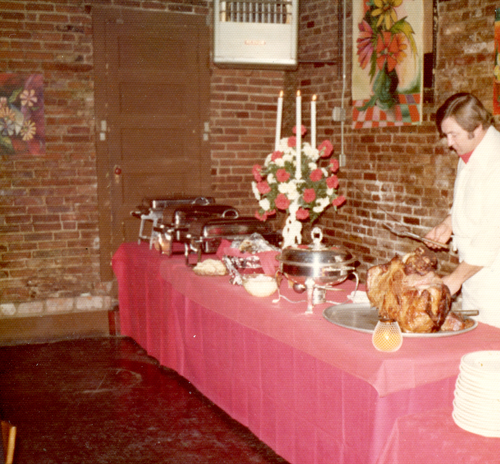
December 23, 2016: I guess because of bad experiences that I had when I was a child, I got to where I did not like anyone having a birthday party for me.
My birthday was a few weeks from Christmas and I can't recall all the times I would hear an adult say “Jimmy's birthday is so close to Christmas we will just get him something for Christmas” knowing all the while they were not going get you anything. When your a little kid, that shit hurts.
After Jerry Edwards and I entered into the bar business (The Red Bull and The French Market) this stigma still bothered me. I decided to do something in a more positive way. There were at that time Toys For Tots programs which military organizations ran for underprivileged children.
I checked with a few hospitals to find out if any of them needed help in acquiring toys at Christmas time. The one hospital that attracted my attention was Cardinal Glennon's Children Hospital. No organization at that time donated toys to their hospital.
This is what I did on my birthday in the early 1970s, I had a Toys for Tots collection for them. Every time I did this, it went passed all my exceptions. We started the drive two weeks before my birthday at both bars - The Red Bull and The French Market - and we filled up with new toys and gifts of money.
I wanted to make sure the hospital got everything. I had someone who represented Cardinal Glennon's Hospital be present on the final night to collect the donated money and toys.
I will never be able to express in words how that made me feel. There is a reason for everything in this world and I really believe what happened to me as a child set me in the right direction to help others and in turn gave me back meaning of the day I was given birth.
Not knowing at the time when we had the toy collection how far reaching the effects would be. The first News Years Eve at The French Market several policeman and fireman came in in full dress uniform. All were smiling and their head spokesman happily let us know they were there to tend bar and to wait on our customers. There was no way we could say no especially when most of them were so damn good looking.
Of course Blanche stayed at the bar to make sure they served the drinks correctly and the girls made sure the waiters knew what to do. We still were supposed to close at 1:30 am. When that time arrived they informed me to forget it. There was not a cop in town that would close us and we could stay open all night if we wanted to. And we did. Why were they doing this? It seems that all policemen and firemen had children who were treated at Cardinal Glennon's Children Hospital and it was their way of returning the favor. How do you like those apples!
Picture: Every Christmas we also gave away free dinners to all our customers from all our locations that no longer had a family to go to, or were no longer welcome at home. Many of our friends volunteered their time on the holidays to make this a festive occasion. The French Market, early 1970s holiday buffet.
Image courtesy James Hawkins
